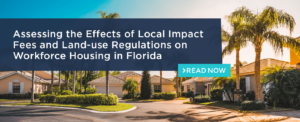Adam Millsap Ph.D., Samuel Staley Ph.D., and Vittorio Nastasi
Executive Summary
Housing rents and home prices in many areas of the nation, including Florida, have increased much faster than the cost of construction since the 1990s, squeezing the household budgets of middle- and lower-income families. According to a report from the Joint Center for Housing Studies of Harvard University (2018), national median rent rose 20 percent faster than overall inflation from 1990 to 2016 while the national median home price rose 41 percent faster.
Housing prices in Florida are growing rapidly
In Florida, rapid population growth has created a demand for more housing. The state’s population has increased by 284,566 on average between 2010 and 2016 according to the U.S. Census Bureau. The average household size is 2.48, implying Florida has increased the demand for housing by nearly 115,000 households each year. Yet, just 57,952 new housing units are added to the stock of housing each year. Increasing the number of homes to meet the rising demand for housing is critical to Florida’s future.
When supply doesn’t keep up with demand, prices go up. Since 2013, house prices in Florida’s major metropolitan areas have increased by nearly 10 percent per year on average. In many parts of Florida, house prices are four to seven times the area’s median income, which exceeds the commonly accepted threshold of three to four times median income.
Higher home prices can be explained by several factors, some of which are out of the control of policymakers and some of which are a direct result of policies adopted by state and local governments. Higher incomes fuel demand for better housing, for example, resulting in larger homes with more rooms and higher construction quality (on average). Higher costs for construction labor and materials are other factors outside the control of homebuilders and policymakers that can increase the price of housing.
Sometimes, however, public policy increases housing costs. More stringent building codes, for example, require builders to use different or more materials than they otherwise would use. In still other cases, policymakers have a direct impact on housing costs and, ultimately, prices by levying higher taxes and impact fees on new development or causing delays through a cumbersome and lengthy permitting process or growth management review process. Indeed, land-use regulations often restrict the amount of developable land and increase the complexity and uncertainty of the permitting process, significantly increasing housing prices.
Overview of key findings
This paper reviews the effects of impact fees and land-use regulations on new home construction and new home prices in Florida. Several studies find that impact fees increase prices. Two studies find significant evidence that impact fees increase the price of new and existing homes in Florida by about $1 for each $1 of fees.
The impact fees in five jurisdictions in the Bradenton-Sarasota-Fort Myers metropolitan region of Florida are also examined. Assessed impact fees vary widely across this region and the actual fiscal impact may be difficult to estimate for builders. The impact fees are also generally regressive: more affordable houses carry a larger proportional burden of impact fees in each of the jurisdictions. For households on the economic margins of home ownership, even small fees can push homeownership beyond the means of a household at the lower ends of the income range if the fee is fully capitalized into the sales price, a likely effect in tight housing markets.
Other studies examine the effect impact fees have on new construction. Two studies on Florida real-estate markets find that impact fees assessed to fund infrastructure such as roads, schools, and parks increase residential housing construction —both single and multi-family—in suburban areas, although they find no effect on construction rates in central cities or rural areas. This could be due to impact fees serving as a bulwark against other barriers to building, such as land-use regulations.
Regarding land-use regulations, there is evidence that they increase the price of housing in Florida. In dollars, estimates for the price increase due to an additional land-use regulation varies from $14,800 to $22,800 per house, and as a percentage of the total house price the increase is largest for the smallest houses. Since lower-income people tend to buy smaller houses, this suggests land-use regulations have a regressive effect on Florida home buyers.
Permitting requirements can also increase the price of housing. Some amount of oversight in the form of a municipal permitting process may be desirable, but a permitting process that is confusing or ambiguous can adversely impact the housing market. One study finds that the cost of permitting delay averages 5.9 percent of the selling price of a finished lot and 1.7 percent of the selling price of a finished home. When applied to houses in Lee County, Fort Myers, and Manatee County, the cost increase associated with permitting delay ranges from $3,300 to $6,900 per house.
Recommendations
Despite the regressive effects of many impact fees, municipalities may not want to eliminate them altogether. New development needs infrastructure and city services and well-designed impact fees are an effective and efficient way to provide such things. Nevertheless, municipalities can implement several reforms to make impact fees less burdensome andless regressive, and thereby improve housing affordability.
- Ensure fee amounts (and formulas) are linked to rigorous studies of public service costs and delivery. Currently, a wide range of fees appears to be levied. The lack of transparency in the formulas and the sources of the estimates suggests some fees may not meet the rational dual nexus test embedded in the spirit and intent of state statute.
- Ensure the impact fees are calculated to reflect the marginal cost of development to the municipality. This way, the fees will act like a user fee and minimize any negative effects on development. Fees that are linked to the size of the unit, as suggested above, are more likely to achieve this. The formula for calculating impact fees should be made available to builders and the public at large to increase transparency.
- Assess impact fees at the time of application, not at the end of the process. Assessing fees at the final stage of the land development process can generate uncertainty as significant lags occur between application dates and issue dates. To reduce uncertainty, municipalities should assess impact fees at the time of application and not apply any subsequent changes retroactively.
- Link fees to the size of the unit to make fees less regressive. Fees that are linked to square footage are less regressive than fees that are linked to number of bedrooms or only linked to unit type, e.g. single-family home (see Been 2005 p.167 for discussion).
- Once the formula for calculating impact fees is established, an impact fee schedule should be calculated and made public. The schedule should be easy to understand and be relatively stable. A schedule with these characteristics makes it easier for developers to plan projects by reducing uncertainty. Individual or one-off impact fee assessments should be avoided since they increase uncertainty.
City officials should also be mindful of how restrictive land-use regulations increase housing prices. Policies that require developers to use more land than they otherwise would, such as minimum lot sizes, minimum parking requirements, or height limits that restrict density, all contribute to higher housing prices. Cities that want housing to be more affordable need to do what they can to make it less costly to build housing, and relaxing land-use regulations is a step in that direction.












